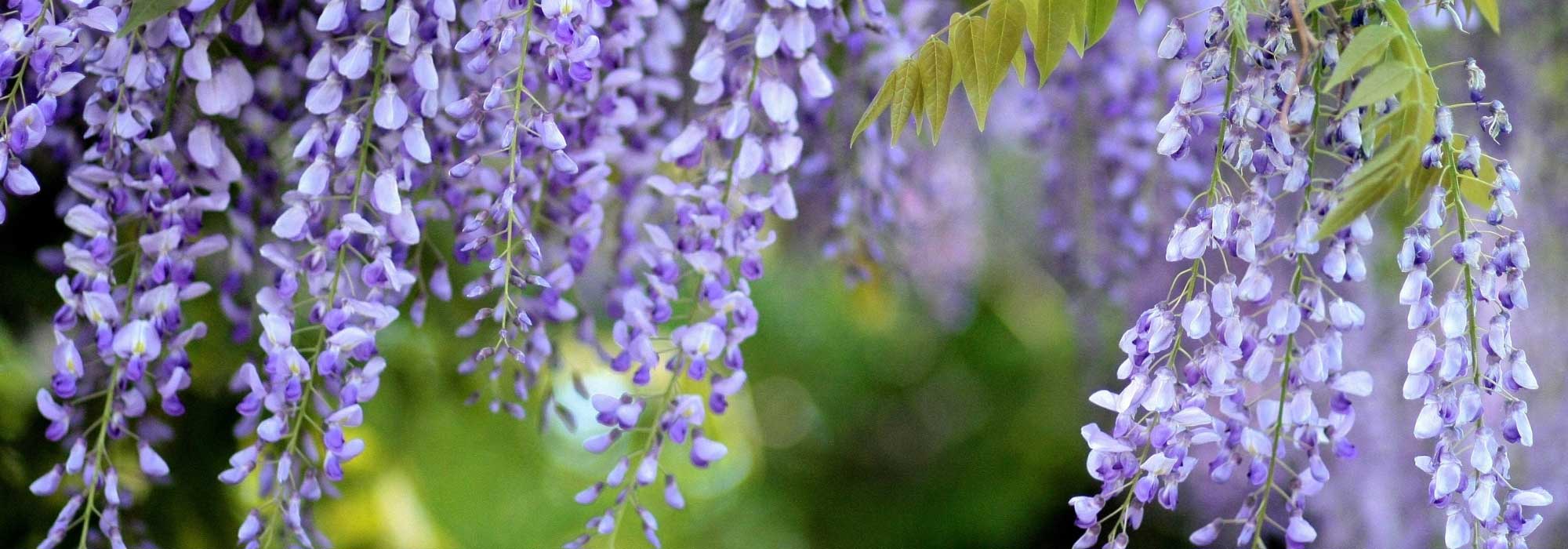
6 pairing ideas with wisteria
Our ideas to enhance wisteria in the garden
Contents
Well known to all, wisterias are beautiful climbing plants with generous and fragrant flowering. Whether their clusters of flowers are blue, white, or pink, they brighten up spring and climb up walls or any support where their tendrils can cling. Even though they are sufficient on their own to green and flower the spaces where they are planted, they can be enhanced by associations with other flowering plants: beautiful perennials planted at their base, shrubs that will harmonise with them, or other climbing plants intertwined that will take over to extend the display of flowering. If you are looking for ideas to pair them pleasantly, discover our 6 atmospheres around wisteria, featuring companion plants that will highlight and accompany it through the seasons.
→ Also find all our tips in our complete guide: “Wisteria: how to plant, prune, and care for it“.
In a garden with southern accents
The resilience of wisteria to different types of soil and climates allows it to be planted in full sun and dry conditions. Gardeners in the south are therefore not left out when it comes to growing this beautiful liana, which quickly establishes itself on a pergola to create a much-needed shade in summer! For example, plant at the foot of Wisteria ‘Grande Diva Nathalie’, with its generous blue and white flowering, alongside sun-loving perennials such as lavenders, santolines, and gauras, punctuated by graphic tufts of Phormium, also known as New Zealand flax. Alternate the species for a natural effect, or plant in masses for a spectacular display of blooms. The wisteria will herald spring with its soft colours, while the perennials will take over once it has finished flowering. Take care with the planting of your wisteria to give it every chance to establish properly and root deeply: a wide, deep, well-loosened planting hole, drainage at the bottom if your soil is clayey, and a mix of potting soil with your garden soil if it is a bit poor. Monitor watering during the first two years: your wisteria will then be able to withstand dry periods without damage!
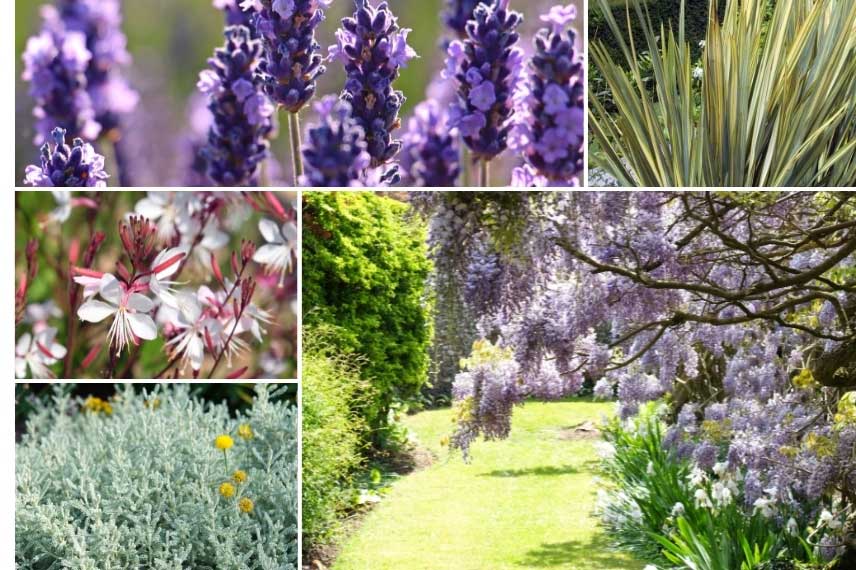
Clockwise: lavenders in bloom in the heart of summer, phormium, wisteria in bloom in summer, santoline and gauras in bloom all summer
Read also
Wisteria: how to train and prune it?In a white garden
The collective imagination often associates wisteria with the soft, characteristic mauve-blue… but of course, there are white wisterias, whose elegant clusters provide the perfect excuse to create a pristine green room or a spotless terrace corner. For white flowering, choose the Chinese Wisteria Wisteria sinensis ‘Alba’, the Japanese Wisterias Wisteria floribunda ‘Alba’ or Wisteria venusta, vigorous and hardy. Their long stems will wrap around sturdy supports to quickly cover pergolas, trellises, or arbours. White flowering perennials such as campanulas, Agapanthus africanus ‘Albus’ or Astilbes depending on your region, soil type, and exposure, will pair beautifully with tall grasses for an elegant and easy-to-maintain white garden.

Clockwise: white wisteria, a minimalist terrace, agapanthus, astilbes, and grasses
Discover other Wisterias
View all →Available in 0 sizes
Available in 0 sizes
Available in 0 sizes
Available in 0 sizes
Available in 2 sizes
Available in 1 sizes
Available in 0 sizes
Available in 1 sizes
Available in 3 sizes
Available in 1 sizes
With other climbing plants to complement and extend the flowering periods
On a pergola, an arch, or against a wall, pairing wisteria with other climbing plants helps to compensate for its short flowering period with climbers that will take over. Feel free to plant one or more climbing roses in soft pink tones, such as the timeless Climbing Rose ‘Clair Matin’, covered in flowers from May to October, or the Climbing Rose ‘Jasmina’, which is very floriferous and delightfully fragrant for long months between June and October. The soft green foliage of the wisteria will serve as a backdrop for them. A Clematis montana ‘Mayleen’ will intertwine its lovely soft pink flowers in May with those of a blue wisteria. Finally, for a spectacular wisteria display in tandem, mix together two wisterias with contrasting clusters: Wisteria floribunda ‘Macrobotrys’ and Wisteria floribunda ‘Alba’ or Wisteria sinensis and Wisteria sinensis ‘Alba’, both very floriferous and perfectly hardy.
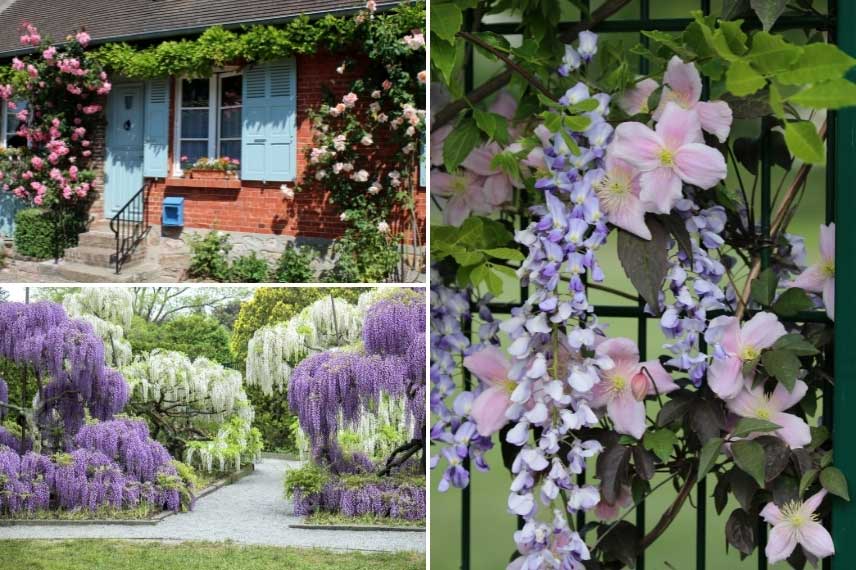
From left to right: The roses colour the walls when the wisteria is out of bloom, a duo of mauve and white wisterias, and wisteria paired with a clematis
Read also
Choosing your wisteria: buyer's guideShowcasing wisteria in a pot
Wisteria flowers are not just for lucky gardeners with a garden: a potted wisteria can easily find its place on a balcony or in a small courtyard without direct soil. Ensure you can plant it in a container large enough for it to develop properly. You can train it on a support against a wall, let it climb a post, or over an arch. Over time, your wisteria will form a strong trunk, gradually wrapping around the support. In a contemporary, minimalist terrace, a white wisteria like Wisteria sinensis ‘Alba’ or Wisteria venusta will be perfect. Plant bulbs of Tulbaghia violacea ‘Pearl’ at the base, which will bloom all summer when the wisteria has finished flowering. In other pots, combine Mexican oranges Choisya ternata, boxwood balls buxus, and hang pots of Chlorophytum nepalense and variegated trailing ivy gracefully like Hedera helix ‘Glacier’. For a more natural and fragrant atmosphere, combine a beautiful Japanese wisteria Wisteria venusta ‘Rosea’ in terracotta pots with a few bulbs of Oxalis adenophylla planted at the base. Be sure to regularly provide water and fertiliser to your potted wisterias.
⇒ Discover all our tips for growing a wisteria in a pot
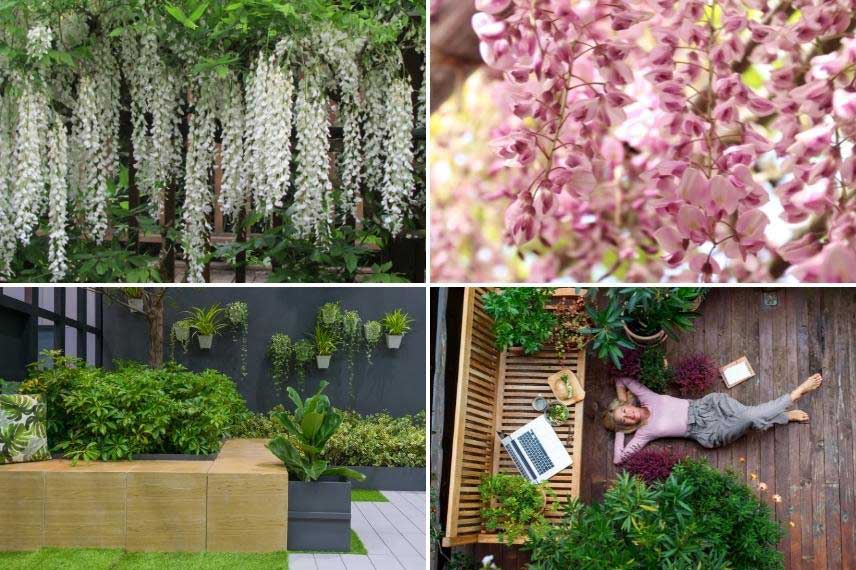
Potted wisterias on the terrace brighten up spring with their flowering
In a rural setting
The “look” of wisteria truly lends itself to natural, simple, and rustic settings. Climbing on the pillar of a tile apprentice, the Japanese Wisteria Wisteria floribunda ‘Honbeni’, which produces wonderful light pink clusters in May, will be the highlight of a display combining balls of boxwood, lupins, agastaches, and sweet peas. In all simplicity, flowers, vegetables, and herbs complement each other, delighting the eyes and the taste buds!
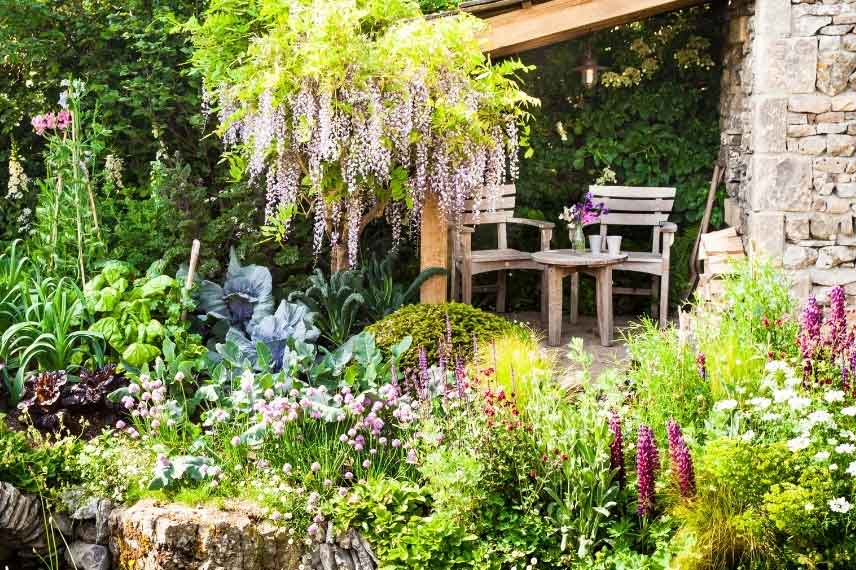
Wisteria floribunda ‘Honbeni’ dominating a composition of perennials, herbs, and vegetables
In a romantic garden
Use majestic trees to support wisteria or allow it to naturally form a trunk over the years. Planted at the end of a gravelled path, it will enhance the perspective where perennials will be welcome on either side: masses of Alchemilla mollis, various sages, peonies, and foxgloves, supported by hedges of hornbeams. A lovely bench made of wood or wrought iron placed at the end of the path completes the scene! You don’t need a vast garden to create this type of setting: the path can be narrower, shorter… what matters here is the structure of the display, simple yet always effective. If the dimensions of your garden allow, you can also combine wisteria in a small garden surrounded by hedges of leafy plants and structured perennials behind low boxwood hedges.
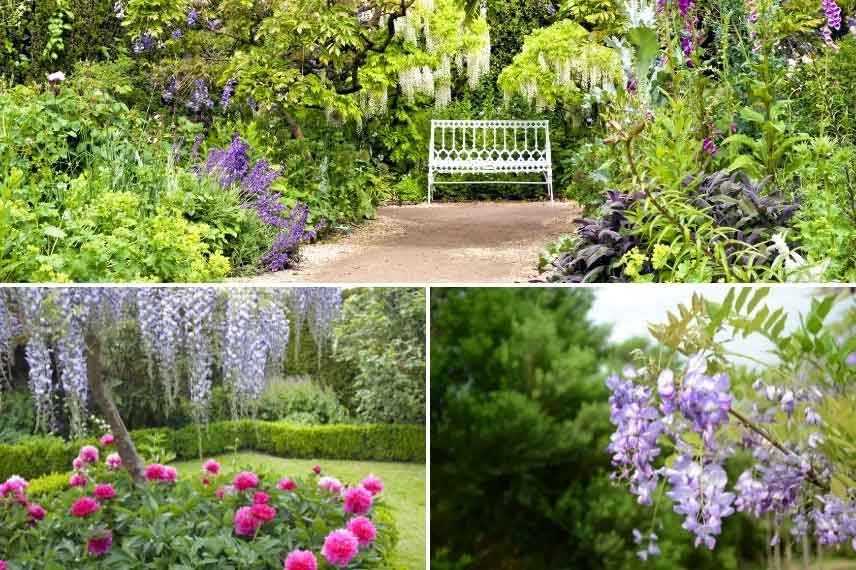
Romantic atmospheres blending wisteria flowers and perennials
- Subscribe!
- Contents
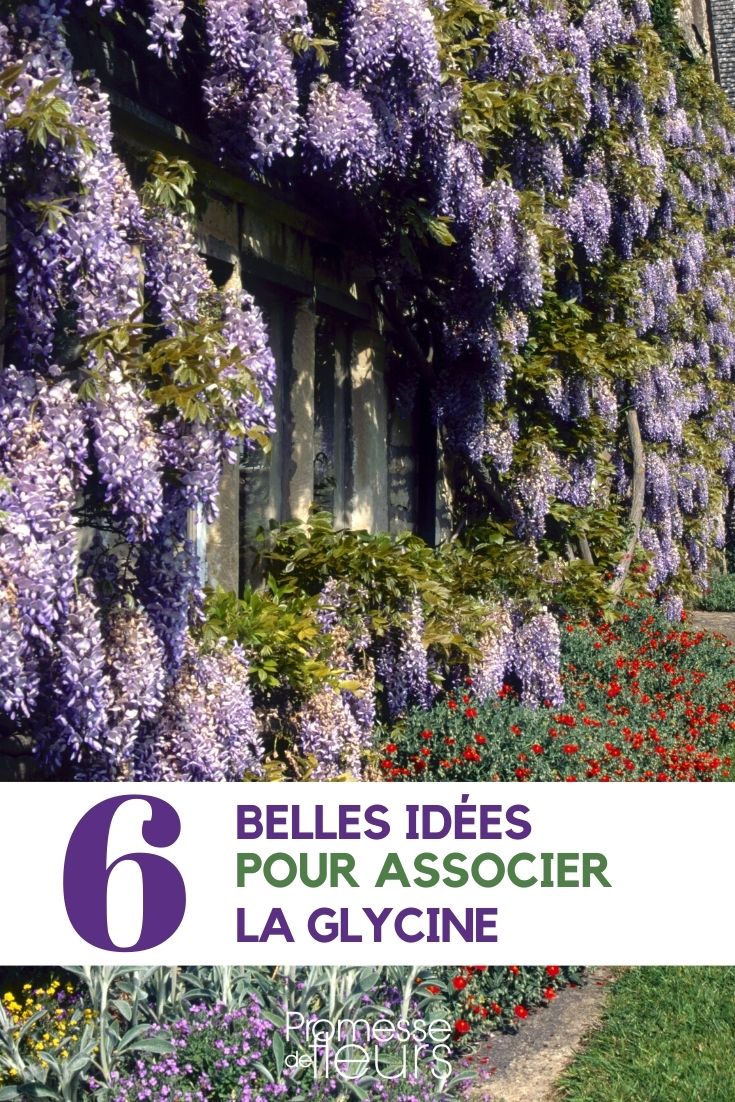































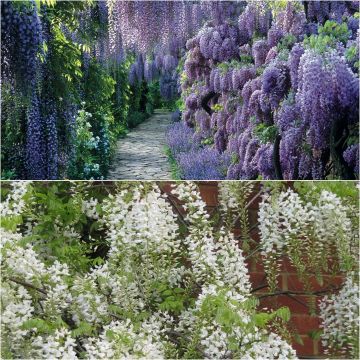
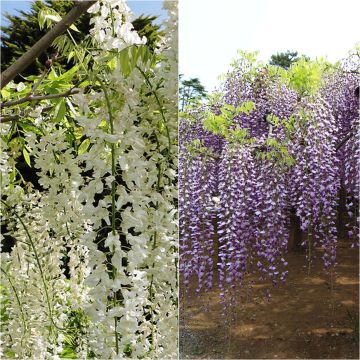



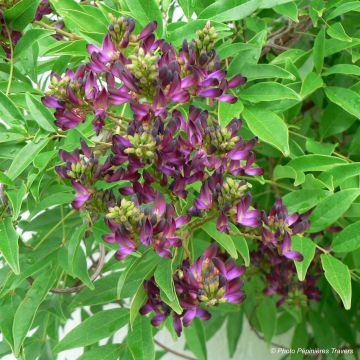
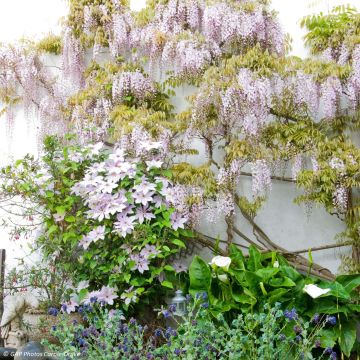
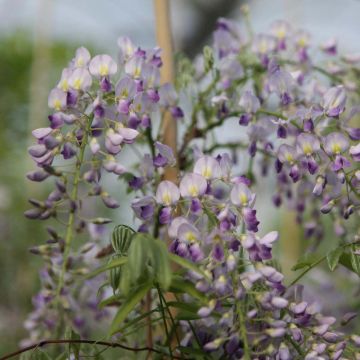
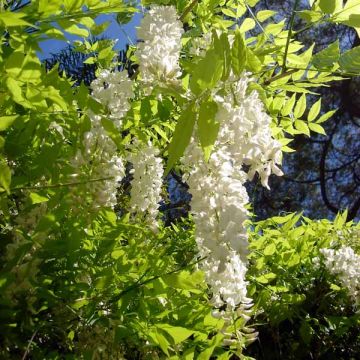
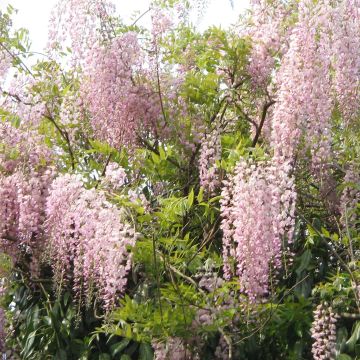
Comments